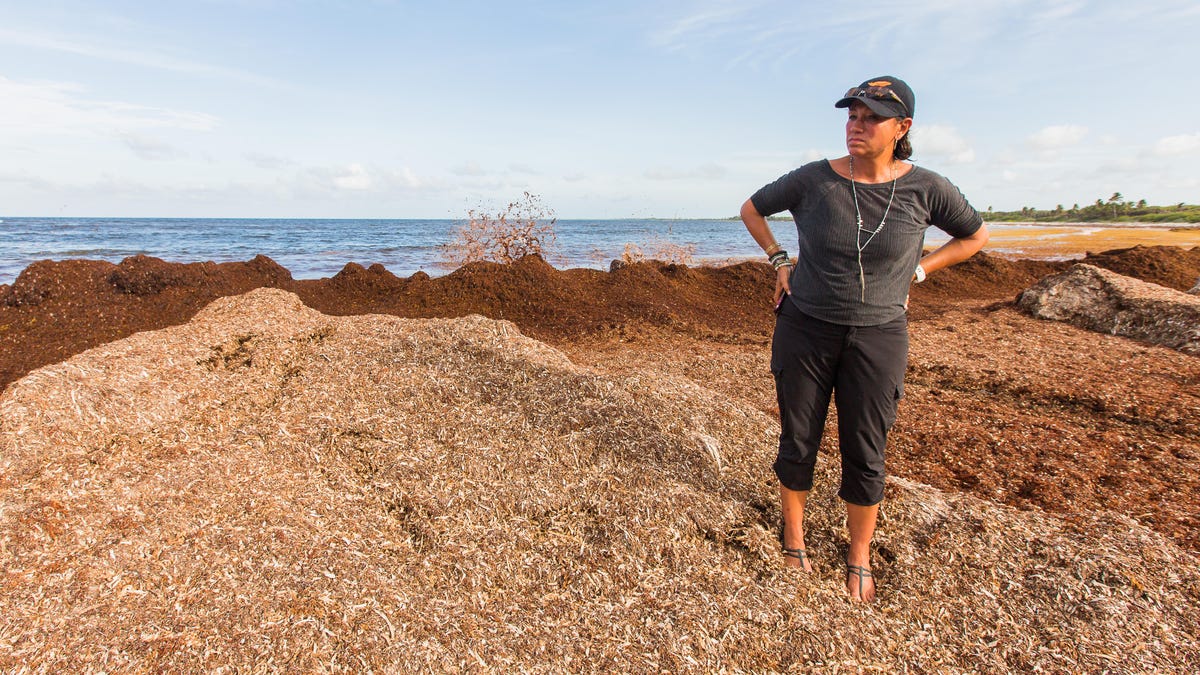Seaweed is gobbling up Mexican beaches
Sargassum, a brown algae, is dangerous to coastal ecosystems and to humans.

Cristina Mittermeier, a marine biologist, photographer and SeaLegacy co-founder, stands on sargassum piled high over the sand on a beach in the Sian Ka'an Biosphere Reserve.
A seaweed called sargassum is invading coastal Mexico, and scientists aren't sure why. "It's complicated," says Mengqiu Wang, a postdoctoral researcher at the University of South Florida College of Marine Science.
Sargassum is a "critical marine habitat" out on the open ocean, providing shelter and food to sea life, but it poses health risks to coastal ecosystems including humans, Wang says. Since 2011, sargassum has been flooding shorelines in the Gulf of Mexico and the Caribbean Sea, confounding researchers because the brown macroalgae used to bloom -- and stay -- in the middle of the ocean. That's no longer the case.
Wang and her team maintain a satellite-based sargassum watch system, showing how the sargassum is dispersed across the Caribbean with images from NASA. Her goal is to further develop predictive algorithms to determine whether sargassum will continue be an issue for coastal communities in upcoming years.
I traveled to Akumal and Tulum on Mexico's Yucatan Peninsula with marine biologist, photographer and SeaLegacy co-founder Cristina Mittermeier, in late July. The purpose? To profile her -- her life and her work, which happen to be closely linked. We also found a lot of sargassum.
I set off to learn more about this smelly algae and why it was wreaking havoc on coastal Mexico.
Sargassum is a good thing, just not on the coast
On land, sargassum smells like rotten eggs and takes away from the beauty of the beaches. In some cases, like in the Sian Ka'an Biosphere Reserve (pictured above), the seaweed covers the sand almost entirely. At that level, the seaweed can prevent turtles from nesting, as they can get tangled and stuck -- or have trouble reaching the beach at all.
A study suggests that sargassum on beaches can exacerbate preexisting health conditions in humans, or cause new ones. The research highlights everything from respiratory ailments like asthma and headaches to memory loss, all attributed to the toxic gases produced as the seaweed dies, such as hydrogen sulphide and ammonia.
As the sargassum approaches the shore and begins to decay, it uses up more oxygen, creating what Wang calls a "low-oxygen zone." That means coral reefs, sea grass, fish, turtles and other sea life can be starved of oxygen by sargassum in coastal waters.
In the coastal town of Akumal, Mexico, Mittermeier and I encountered teams of people, pitchforks in hand, piling the sargassum into trailers to move it away from tourists. "People aren't coming here [because of the seaweed]," one employee told us. I can confirm that rotting sargassum smells awful, even from a distance, and it's an eyesore for visitors expecting white sandy beaches.
A team in Akumal, Mexico gathers dead sargassum seaweed and piles it into trucks to be hauled away. It smells awful.
What causes it?
Melting polar ice mixing with salt water could be causing the sargassum to grow and spread more than in previous years, Mittermeier says. She also mentions deforestation in the Amazon and an increase in the use of fertilizer running into the Amazon River, and then into the ocean, as another possible cause.
Wang's research supports deforestation in the Amazon as a potential cause, which she detailed in a recent study she and her colleagues published in the journal Science. As fertilizer in the Amazon region runs off into the Amazon River and eventually the ocean, it creates "increased nutrient conditions that stimulates the sargassum," Wang says. In the middle of the ocean, sargassum typically doesn't have a lot of nutrients to stimulate its growth, but the fertilizer run-off could be feeding it and helping it grow.
As more sargassum blooms, there's a better chance of it reaching the coast and hurting local communities, in terms of both tourism and health care, from repeated exposure to the toxic gases.
There are also theories that dust from the Sahara Desert and shifting surface water off the coast of west Africa contribute to the increase in sargassum growth.
The 'new normal'
Sargassum isn't new. Christopher Columbus wrote about it in the 15th century, Wang says.
However, she and other scientists at the University of South Florida are studying a "great Atlantic sargassum belt," a continuous stretch of sargassum that spans from West Africa to the Gulf of Mexico -- roughly 5,500 miles -- dubbing it "the world's largest macroalgal bloom." That's not typical.
And regardless of the specific cause, or causes, of the sargassum growth, there's one thing all of these theories have in common: Something far away is contributing to changing conditions on these beaches in Mexico, hurting tourism and making the area less hospitable for the humans, animals and plants here.
Wang is fascinated by sargassum and plans to continue researching it to better understand why it has grown so much since 2011. She's also working on algorithms to help better predict the size and location of next year's sargassum blooms. Either way, her research suggests that sargassum clogging up coastal waters could become the "new normal."

